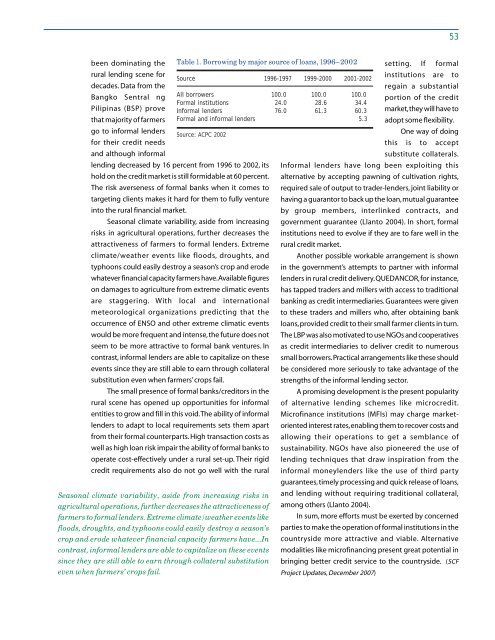Read More - Philippine Institute for Development Studies
Read More - Philippine Institute for Development Studies
Read More - Philippine Institute for Development Studies
You also want an ePaper? Increase the reach of your titles
YUMPU automatically turns print PDFs into web optimized ePapers that Google loves.
53<br />
been dominating the Table 1. Borrowing by major source of loans, 1996–2002 setting. If <strong>for</strong>mal<br />
rural lending scene <strong>for</strong><br />
Source 1996–1997 1999–2000 2001–2002<br />
institutions are to<br />
decades. Data from the<br />
regain a substantial<br />
Bangko Sentral ng All borrowers 100.0 100.0 100.0<br />
portion of the credit<br />
Formal institutions 24.0 28.6 34.4<br />
Pilipinas (BSP) prove In<strong>for</strong>mal lenders 76.0 61.3 60.3 market, they will have to<br />
that majority of farmers Formal and in<strong>for</strong>mal lenders 5.3 adopt some flexibility.<br />
go to in<strong>for</strong>mal lenders<br />
Source: ACPC 2002<br />
One way of doing<br />
<strong>for</strong> their credit needs<br />
this is to accept<br />
and although in<strong>for</strong>mal<br />
lending decreased by 16 percent from 1996 to 2002, its<br />
hold on the credit market is still <strong>for</strong>midable at 60 percent.<br />
The risk averseness of <strong>for</strong>mal banks when it comes to<br />
targeting clients makes it hard <strong>for</strong> them to fully venture<br />
into the rural financial market.<br />
Seasonal climate variability, aside from increasing<br />
risks in agricultural operations, further decreases the<br />
attractiveness of farmers to <strong>for</strong>mal lenders. Extreme<br />
climate/weather events like floods, droughts, and<br />
typhoons could easily destroy a season’s crop and erode<br />
whatever financial capacity farmers have. Available figures<br />
on damages to agriculture from extreme climatic events<br />
substitute collaterals.<br />
In<strong>for</strong>mal lenders have long been exploiting this<br />
alternative by accepting pawning of cultivation rights,<br />
required sale of output to trader-lenders, joint liability or<br />
having a guarantor to back up the loan, mutual guarantee<br />
by group members, interlinked contracts, and<br />
government guarantee (Llanto 2004). In short, <strong>for</strong>mal<br />
institutions need to evolve if they are to fare well in the<br />
rural credit market.<br />
Another possible workable arrangement is shown<br />
in the government’s attempts to partner with in<strong>for</strong>mal<br />
lenders in rural credit delivery. QUEDANCOR, <strong>for</strong> instance,<br />
has tapped traders and millers with access to traditional<br />
are staggering. With local and international banking as credit intermediaries. Guarantees were given<br />
meteorological organizations predicting that the<br />
occurrence of ENSO and other extreme climatic events<br />
would be more frequent and intense, the future does not<br />
seem to be more attractive to <strong>for</strong>mal bank ventures. In<br />
contrast, in<strong>for</strong>mal lenders are able to capitalize on these<br />
events since they are still able to earn through collateral<br />
substitution even when farmers’ crops fail.<br />
The small presence of <strong>for</strong>mal banks/creditors in the<br />
rural scene has opened up opportunities <strong>for</strong> in<strong>for</strong>mal<br />
entities to grow and fill in this void. The ability of in<strong>for</strong>mal<br />
lenders to adapt to local requirements sets them apart<br />
from their <strong>for</strong>mal counterparts. High transaction costs as<br />
well as high loan risk impair the ability of <strong>for</strong>mal banks to<br />
operate cost-effectively under a rural set-up. Their rigid<br />
credit requirements also do not go well with the rural<br />
to these traders and millers who, after obtaining bank<br />
loans, provided credit to their small farmer clients in turn.<br />
The LBP was also motivated to use NGOs and cooperatives<br />
as credit intermediaries to deliver credit to numerous<br />
small borrowers. Practical arrangements like these should<br />
be considered more seriously to take advantage of the<br />
strengths of the in<strong>for</strong>mal lending sector.<br />
A promising development is the present popularity<br />
of alternative lending schemes like microcredit.<br />
Microfinance institutions (MFIs) may charge marketoriented<br />
interest rates, enabling them to recover costs and<br />
allowing their operations to get a semblance of<br />
sustainability. NGOs have also pioneered the use of<br />
lending techniques that draw inspiration from the<br />
in<strong>for</strong>mal moneylenders like the use of third party<br />
guarantees, timely processing and quick release of loans,<br />
Seasonal climate variability, aside from increasing risks in<br />
agricultural operations, further decreases the attractiveness of<br />
farmers to <strong>for</strong>mal lenders. Extreme climate/weather events like<br />
floods, droughts, and typhoons could easily destroy a season’s<br />
crop and erode whatever financial capacity farmers have...In<br />
contrast, in<strong>for</strong>mal lenders are able to capitalize on these events<br />
since they are still able to earn through collateral substitution<br />
even when farmers’ crops fail.<br />
and lending without requiring traditional collateral,<br />
among others (Llanto 2004).<br />
In sum, more ef<strong>for</strong>ts must be exerted by concerned<br />
parties to make the operation of <strong>for</strong>mal institutions in the<br />
countryside more attractive and viable. Alternative<br />
modalities like microfinancing present great potential in<br />
bringing better credit service to the countryside. (SCF<br />
Project Updates, December 2007)










